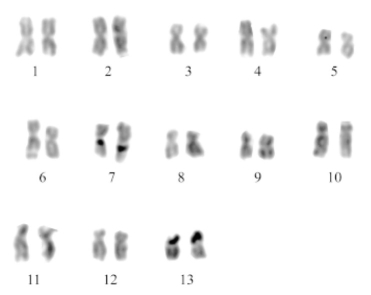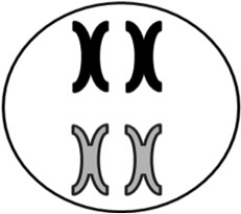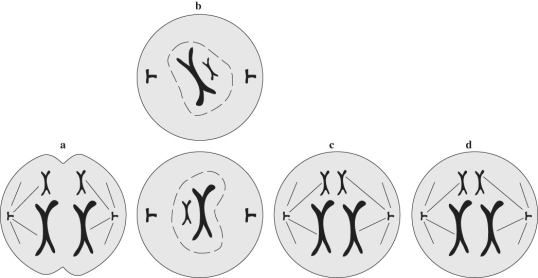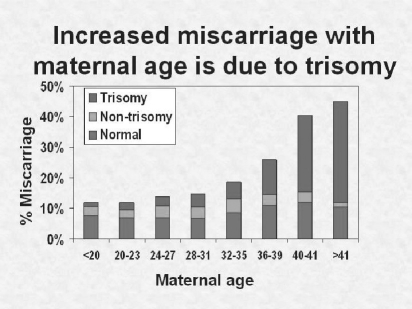A) anaphase I of meiosis
B) alignment of tetrads in metaphase I
C) crossing over
D) random alignment of homologous chromosomes in meiosis I
F) A) and C)
Correct Answer

verified
C
Correct Answer
verified
Multiple Choice
Adaptation to a changing environment is likely to occurs most quickly through which of the following processes?
A) mutation
B) asexual reproduction and genetic recombination
C) sexual reproduction
E) A) and C)
Correct Answer

verified
Correct Answer
verified
Multiple Choice
Hexaploid wheat was produced synthetically by He and coworkers.They mated the diploid species,Aegilops tauschii,and the tetraploid species,T.turgidum.Which of the following is an accurate statement about the relative contribution of each parent to the genome of the hexaploid offspring?
A) Each parent contributed equally to the genome of the offspring.
B) Aegilops tauschii contributed four chromosomes by failing to complete meiosis after chromosome replication,and T.turgidum contributed two chromosomes.
C) Aegilops tauschii contributed two chromosomes,and T.turgidum contributed four chromosomes.
D) The hexaploid number appeared following mitosis with no subsequent cell division.
F) B) and C)
Correct Answer

verified
Correct Answer
verified
Multiple Choice
Figure 12.2  -The karyotype shown above is that of a snail,Pomacea patula catemacensis.What is the diploid number for this organism?
-The karyotype shown above is that of a snail,Pomacea patula catemacensis.What is the diploid number for this organism?
A) 13
B) 26
C) 46
D) 7
F) A) and B)
Correct Answer

verified
B
Correct Answer
verified
Multiple Choice
Which of the following is the difference between trisomy and triploidy?
A) Trisomic individuals have three copies of a specific chromosome;triploid individuals have three copies of every chromosome.
B) Trisomic individuals have three copies of every chromosome;triploid individuals have three copies of a specific chromosome.
C) There is no difference between the two terms-they mean the same thing.
D) Trisomic individuals have three copies of one gene on one chromosome;triploid
F) B) and D)
Correct Answer

verified
Correct Answer
verified
Multiple Choice
Centromeres split and sister chromosomes migrate to opposite poles in
A) anaphase I.
B) prophase II.
C) anaphase II.
D) telophase II.
F) B) and C)
Correct Answer

verified
Correct Answer
verified
Multiple Choice
 -Just prior to meiosis,DNA is replicated.Each resulting piece of replicated DNA is considered to be ________ chromosome(s) and is made up of ________ chromatic(s) .
-Just prior to meiosis,DNA is replicated.Each resulting piece of replicated DNA is considered to be ________ chromosome(s) and is made up of ________ chromatic(s) .
A) 1;1
B) 1;2
C) 2;2
D) 1;4
E) 2;4
G) A) and B)
Correct Answer

verified
Correct Answer
verified
Multiple Choice
The bulldog ant has a diploid number of two chromosomes.Therefore,following meiosis,each daughter cell will have a single chromosome.There is/are ________ different possible combination(s) of genes in the daughter cells of meiosis because ________.
A) one;there is only one chromosome per cell
B) two;there are two homologous chromosomes per cell prior to meiosis
C) more than 2;the two homologues cross over
E) A) and C)
Correct Answer

verified
Correct Answer
verified
Multiple Choice
Crossover,the exchange of segments of homologous chromosomes,takes place during which of the following processes?
A) DNA replication
B) cytokinesis
C) anaphase I
D) synapsis
F) All of the above
Correct Answer

verified
Correct Answer
verified
Multiple Choice
Figure 12.4  -Refer to Figure 12.4.Put the stages of meiosis shown here in the order that they would occur in a cell.
-Refer to Figure 12.4.Put the stages of meiosis shown here in the order that they would occur in a cell.
A) a,c,d,b
B) c,a,b,d
C) c,a,d,b
D) a,b,c,d
F) A) and D)
Correct Answer

verified
Correct Answer
verified
Multiple Choice
Sister chromatids separate during
A) anaphase I.
B) metaphase I.
C) anaphase II.
D) interkinesis.
F) B) and C)
Correct Answer

verified
C
Correct Answer
verified
Multiple Choice
Which of the following would enable you to detect aneuploidy?
A) autosomy
B) karyotyping
C) syngamy
D) synapsis
F) A) and C)
Correct Answer

verified
Correct Answer
verified
Multiple Choice
Chromosomes and their homologues align at the equator of the cell during
A) prophase I.
B) metaphase I.
C) prophase II.
D) metaphase II.
F) A) and B)
Correct Answer

verified
Correct Answer
verified
Multiple Choice
What happens when an individual has an odd number of chromosome sets (e.g.,triploidy) ?
A) They produce offspring with an even number of chromosome sets (e.g.,tetraploid,hexaploid) .
B) Their offspring are often sterile.
C) They go through three sets of meiosis (meiosis I,meiosis II,and meiosis III)
D) Their cells are unable to complete meiosis.
F) A) and D)
Correct Answer

verified
Correct Answer
verified
Multiple Choice
Figure 12.1  -What can you infer from the karyotype shown in Figure 12.1?
-What can you infer from the karyotype shown in Figure 12.1?
A) There is a translocation in one of the chromosome 8 homologues.
B) This individual has a single sex chromosome.
C) This individual has an abnormal number of autosomes.
D) This is a karyotype of a male.
F) All of the above
Correct Answer

verified
Correct Answer
verified
Multiple Choice
In 1985,Hassold and Chiu found that the likelihood of miscarriage increased with maternal age.What is the most likely explanation for the relationship between age and miscarriage?
A) Women in their mid-thirties and older have more health problems that interfere with their ability to maintain pregnancy.
B) Older women typically have hormonal imbalances that prevent them from carrying a baby to term.
C) The DNA replication that takes place immediately prior to meiosis is less accurate in older women.
D) Ova are arrested in meiosis until ovulation.As a result,completion of meiosis in the older woman is more likely to result in aneuploidy or other chromosomal abnormalities.
F) A) and D)
Correct Answer

verified
Correct Answer
verified
Multiple Choice
 -In the diploid cell above there are ________ chromosomes and ________ chromatids.
-In the diploid cell above there are ________ chromosomes and ________ chromatids.
A) 2;2
B) 4;4
C) 2;4
D) 2;8
E) 4;8 F) 8;8
G) B) and C)
Correct Answer

verified
Correct Answer
verified
Multiple Choice
Somatic cells of roundworms have four chromosomes.How many chromosomes would you find in an ovum from a roundworm?
A) four
B) two
C) eight
D) a diploid number
F) None of the above
Correct Answer

verified
Correct Answer
verified
Multiple Choice
Different types of organisms have different types of life cycles."Alternation of generations" is a life cycle found among land plants and several groups of algae.It is characterized by which of the following?
A) a multicellular diploid state
B) a multicellular haploid state
C) tetraploidy
D) both a multicellular diploid state and a multicellular haploid state
F) B) and C)
Correct Answer

verified
Correct Answer
verified
Multiple Choice
Why might the incidence of trisomy from maternal origin be higher than that from paternal origin?  Source: Hassold,T.,Chiu,D.Human Genetics.1985;70(1) :11-7.)
Source: Hassold,T.,Chiu,D.Human Genetics.1985;70(1) :11-7.)
A) Eggs are arrested in meiosis in the mother from approximately birth until ovulation.
B) Sperm travel to the site of fertilization,and an extra chromosome may slow them down.
C) Eggs move little from their site of release to the site of fertilization.
D) All of the above are possible explanations for the higher incidence of trisomy of maternal origin.
F) A) and D)
Correct Answer

verified
Correct Answer
verified
Showing 1 - 20 of 39
Related Exams